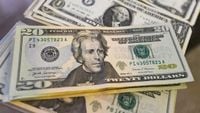The Mexican peso is facing considerable challenges as it continues to decline against the US dollar, driven largely by the recent decisions of the Federal Reserve regarding interest rates. As of March 20, 2025, the peso depreciated significantly, marked by a decrease of 0.84% or 16.8 centavos, reaching a rate of 20.24 pesos per dollar.
This latest drop comes after the Federal Reserve opted to maintain its interest rates unchanged at a range between 4.25% to 4.50%. It appears the market is reacting to Chairman Jerome Powell’s commentary indicating a cautious approach regarding future interest rate cuts amid ongoing uncertainty related to tariffs imposed on goods and services.
Around 07:30 hours local time, the dollar was exchanged for about 20.26 pesos, indicating a slight but notable depreciation from previous sessions. Over the past week, the peso has had its struggles, failing to stabilize at levels below 20 pesos to the dollar, which had previously been observed.
Janneth Quiroz Zamora, the director of Economic Analysis at Grupo Financiero Monex, noted that the peso’s difficulties are strongly related to the strengthening of the dollar. She remarked, “The peso has faced challenges due to the strengthening dollar after the Fed's last monetary policy decision,” emphasizing the direct correlation between the Fed's decisions and international market reactions.
The strengthening dollar was further illustrated by the dollar index's rise of approximately 0.65%, reaching 104.10 units amidst the market volatility regarding foreign exchange. This strengthened position has compounded pressure on the Mexican peso, which had encountered heavier selling in global markets following the Fed's cautious stance.
On Wednesday, March 19, 2025, the Federal Reserve unanimously decided to maintain its rates unchanged and projected a more pessimistic outlook concerning inflation and GDP growth. Markets responded by shedding some of their caution, with Powell mentioning that any inflationary impacts from trade tariffs would be temporary.
The local economic backdrop has been draped in uncertainty as well. The National Institute of Statistics and Geography (INEGI) reported that the activity indicator for February anticipated a year-on-year contraction of 0.7%, leading to concerns about the robustness of the sectors most impacted by the geopolitical tensions and tariff discussions.
Additionally, recent data showed revised growth forecasts for earlier months, with the January projection being adjusted down to an annualized growth of just 0.6% instead of the initially expected 1.8%. This forecasting indicates a notable slowdown in key sectors, particularly manufacturing, hinting at broader economic challenges ahead.
The peso’s fluctuations are symptomatic of wider economic conditions not just in Mexico, but globally, as uncertainties persist regarding interest rates and trade policy implications with the US, especially under the current administration led by former President Donald Trump.
Similarly, on March 20, financial institutions across Mexico, such as Banco Azteca and BBVA, reflected these shifts in their foreign exchange dealings, with rates varying from 19.05 to 20.60 pesos for buying and selling the dollar. Affiliated banks reported a consistent valuation of the dollar hovering around the 20.25 mark across various trading platforms.
As the currency markets open for a new day on March 21, the interbank exchange rate is experiencing further slight improvements, now averaging around 20.19 pesos per dollar. Financial analysts remain skeptical yet hopeful that recent discussions of tariff relaxations may stabilize the peso in the longer term.
Projections for the economic landscape in 2025 remain conservative, with Banxico estimating that inflation will stay below four points until three-point-eight percent and GDP growth may only experience an uptick of about 1.2 percent. The central bank’s forecasts underline just how delicate the current economic environment is and the need for vigilant observation of both domestic policies and international market conditions.
In a situation where the dollar price is fluctuating frequently, stakeholders and investors alike are urged to monitor ongoing developments diligently. The interplay between the Federal Reserve's policies and Mexico’s economic indicators will undoubtedly shape the trajectory of the peso in the coming months.
Given these complex dynamics, the Mexican peso finds itself at a critical juncture, subject to pressures from both domestic and international spheres. As market watchers continue to assess ongoing global economic trends and potential mitigations of trade tensions, observers await the broader impact on the financial environment and the currency's value.








